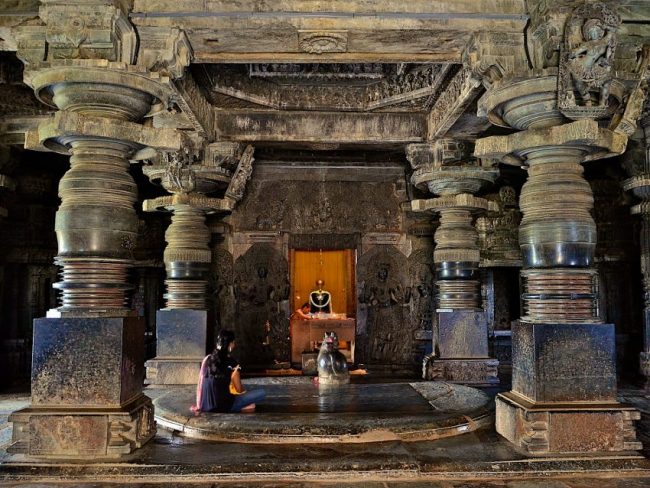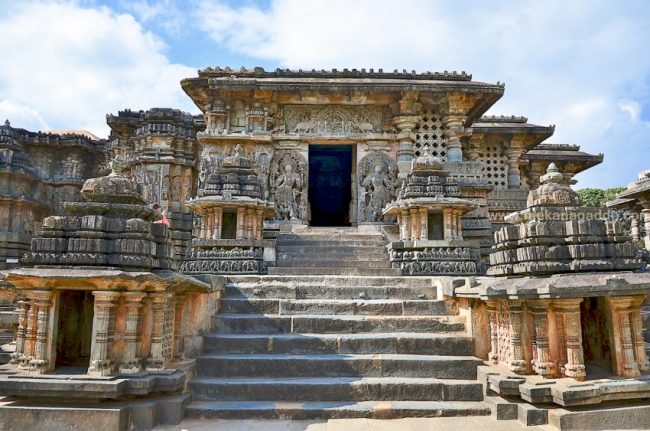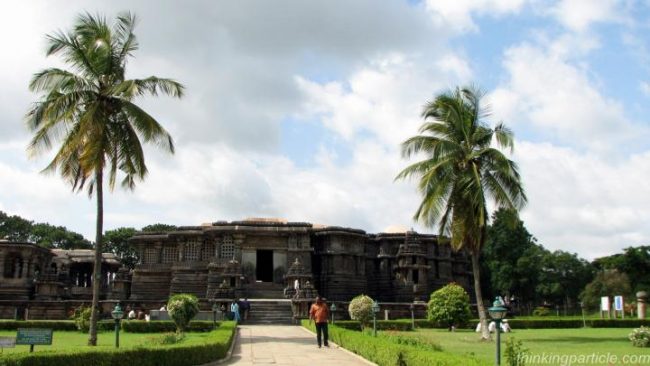Hoysaleshwara Temple is one of the largest temple devoted to the god Shiva in South India.
The temple is a Dvikuta (which means temple with two Vimana/Gopura) devoted to Hoysaleshwara and Shantaleshwara. Before the temple there are two Nandi Mantapas which are delightfully cut and draws in ones consideration quickly.
The temple has two hallowed places and two superstructures, one for “Hoysaleswara” (the ruler) and the other for “Shantaleswara” and is worked with soapstone (or potstone).
The temple complex depends on the stage of jagati,which as indicated by student of history Kamath, is a component that got to be distinctly prominent in contemporary Hoysala developments. As per craftsmanship history specialist Foekema, the two holy places which are bordering, confront the east and each has a mandapa (lobby) in front.
The two mandapas are associated giving an expansive and forcing perspective of the lobby. Exclusively, every place of worship is littler than the one at the Chennakesava temple at Belur and contains a basic Linga, the widespread image of the god Shiva.
The arrangement of the temple is straightforward within, yet the outside looks changed due to the presentation of numerous projections and breaks in the dividers.
The temple was worked at a stature that gave the planners, adequate flat and vertical space to delineate substantial and little figures.

The temple has four yards for passage and the one regularly utilized by guests as principle section is really a sidelong passageway (north).
There is one section on the south side and two on the east side, confronting two extensive confined open structures, the roof of which is upheld by machine turned columns.
All passage patios have small scale hallowed places as flanking. Likewise, there is an asylum for the Sun god Surya, whose picture stands 7 ft (2.1 m) tall.
The structures cherish extensive pictures of Nandi, the bull, an orderly of Shiva. The structures have an indistinguishable jagati from the principle temple.

The temple initially had an open mandapa to which external dividers with penetrated window screens made with a similar material were raised, making the mantapa a shut one.
The inside of the temple is very plain with the exception of the machine turned columns that keep running in lines between the north and south doors. There are no different madanikas in the temple.
The Temple is likewise well known for the uncommon Garuda Sthamba (Garuda column). As indicated by Settar, these are not quite the same as virgals (Hero stone).
Garudas were tip top bodyguards of the lords and rulers. They moved and lived with the illustrious family and their exclusive reason for existing was to ensure their lord. Upon the demise of their lord, they used to confer suicide.
The uncommon column on the south side portrays legends shaking blades and cutting their own heads. The engraving respects Kuruva Lakshma, a bodyguard of Veera Ballala.
Hoysaleswara Temple has two places of worship, one committed to Hoysaleswara and another for Shantaleswara (named after Shantala Devi, ruler of King Vishnuvardhana).
Remaining on a raised stage, the temple is made out of Chloritic Schist (Soapstone, otherwise called potstone). Both of the places of worship are situated beside each other, confronting the east bearing. The holy place contains the Shiva lingam (phallic type of Lord Shiva), the all inclusive image of Lord Shiva.
Other than alternate holy places, there is one holy place that is committed to Lord Surya. Here, Sun God is portrayed in the 7 ft tall picture.
The lobbies include tremendous pictures of Nandi, the orderly of Lord Shiva. Hoysaleswara Temple remains as a tribute of the former time. The remarkable structure of the temple has been certify for being the encapsulation of Hindu design.

How to Reach to Hoysaleswara temple
The temple is about half a kilometre from the bus station of Halebid. You can even come to Hassan and then come to Hoysaleswara temple.
There are State Road Transport Corporation buses that ply between Hassan and Halebid. There is no airport at Hassan but there are many trains that ply between Mysore, Bangalore and Hassan.